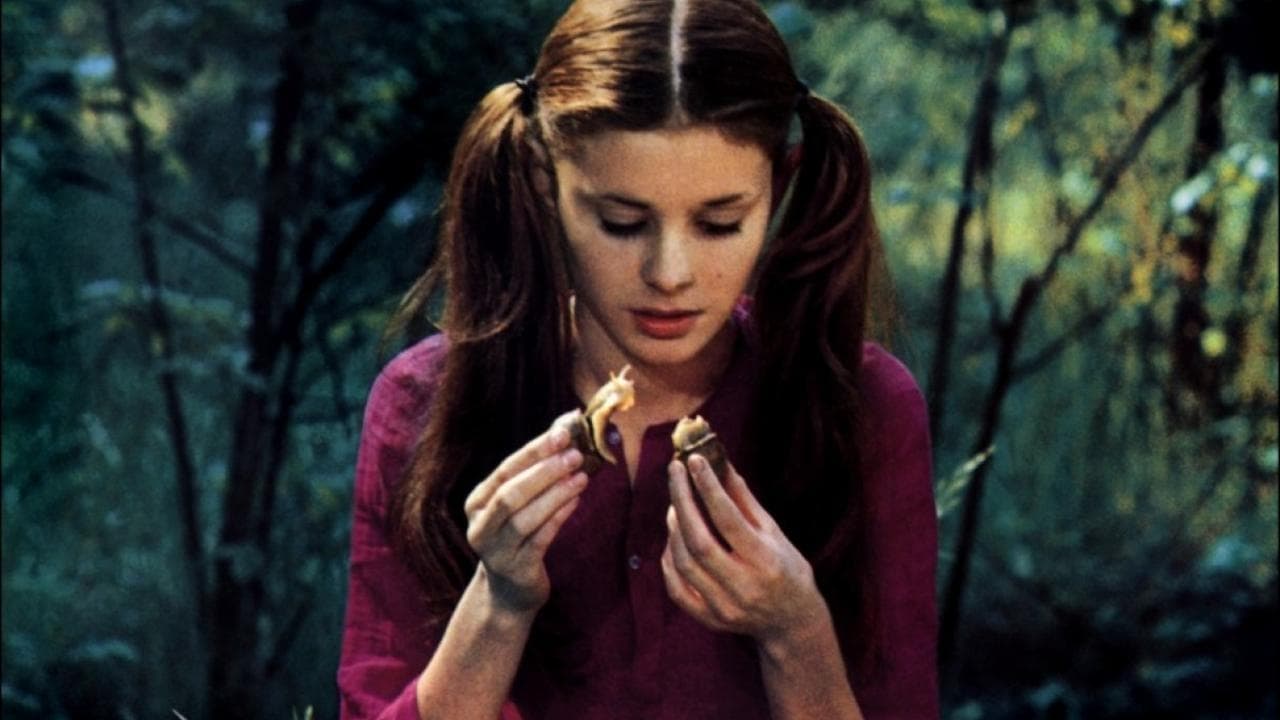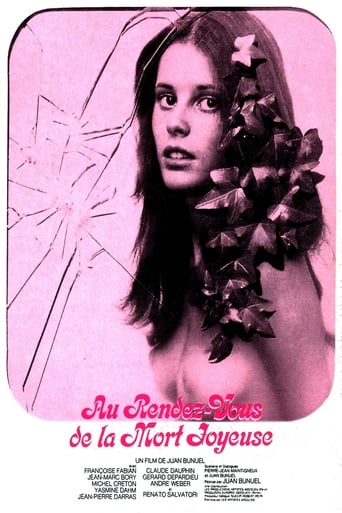

Where was this one hiding? A French art horror film about poltergeists that really delivers the goods on most fronts, even though it's apparent the budget isn't the highest. A French family (chain-smoking mother, annoying child, hard-working father, moody teenage girl) move into a huge creepy mansion and almost right away strange things begin to happen. The teenage girl draws a picture of the mansion that looks a lot different than it actually is. A tin of paint falls over in the kitchen. The boy's toys are broken by someone unseen. During the night most of the windows in the building are violently destroyed by an unknown presence throwing stones. The family are baffled and think the locals have something against them...that is until a table rises up into the air, smashes its way into the house, and destroys a room. In fact, we the audience are clued in on what's happening more than the family, because there's something strange going on with daughter Sophie. At first it seems that she's some kind of telekinetic-type, but it all could be something more to do with something in the house that's either using her or possessing her. It's never really made clear anyway, but by the way Sophie's reflection seems to be moving when Sophie isn't, something aint right.Eventually, when a lecherous visitor gets attacked by kitchen appliances after commenting on Sophie 'starting to become a woman', a television crew are called in to document the weird goings on, with the family moving out for a while. Initially, the crew don't find anything particularly strange happening, save for some old rope left in the boy's bed, but when Sophie reappears, having hitchhiked all the way back there, soundman Gerard Depardieu goes into a trance and plunges his hand into a pan of soup...French onion soup of course!Other things happen but it's not fair to recount every scare scene in case you actually want to go out and watch the thing. It's like the Robert Wise film The Haunting with regards to all the paranormal stuff centred around one person, and like that film doesn't rely on gore to get the chills in. In fact, there's bit of this film have turned up in other horror fiction, especially the 'ball' bit from The Changeling, and really especially Stephen King's work, like the telekinetic girl's house destroyed by stones in the book Carrie, or the sexual ghost coming on to a guy then revealing itself as something horrible in The Shining! There's also a lot of similarities between Salem's Lot and Mario Bava's Black Sabbath while I'm on the subject, and the spider/baby thing from Spider Labyrinth turns up in the Dark Tower books. Don't tell me he doesn't watch these things - he fully admitted getting the idea for the Dark Tower from The Good, The Bad, and The Ugly!Back to the film - A couple of sudden deaths come out of nowhere near the end, and you do have a Haunting-like ending...or no ending at all...it is a French art film after all. I guess it's in how you interpret it. Very good though. That's I'm seeking them all out - to find films like this. Recommended!
... View MoreAn extraordinary first film from Juan Bunuel, son of Luis, and if if does not completely succeed it is certainly a very bold effort. A variation on the old dark house film, the creepy and violent otherness here is of the poltergeist variety, and very violent and creepy it is. Lots of children here and one young girl (the daughter) who may be the main cause of things going very big bump in the night, and the day. This central character is played most convincingly and beautifully by leading model of the time, Yasmine Dahm. Her performance is perfect but the director does not seem to have given the same attention to all and some of the acting seems rather hammy, even a young Gerard Depardieu seems to be over acting, but then, dare I say, this would not be the last time for that! There are several dark sequences and I feel i might have scored this higher had it been a better print.
... View MoreI first became aware of this (whose original title translates to the unfathomable AT THE MEETING WITH JOYOUS DEATH!) at a DVD rental store on Santa Monica Boulevard in Hollywood specializing in cult rarities. I remember liking the film at the time but it is possible that I enjoyed it even more on a second viewing (which basically came via the same exceedingly fuzzy print): even so, a proper restoration would really render the movie justice – I have no idea who might own the rights to it, but an outfit like, say, Mondo Macabro certainly missed an opportunity with the release of PARANORMAL ACTIVITY (2007; though its wide-spread release did not occur until 2 years later) and its brand-new follow-up! The premise, in fact, deals with a family living in a country-house which turns out to be 'alive' – to the point where a TV crew is brought in to 'capture' the paranormal phenomena; though, at the time, this was hardly the ideal choice to pass for one's baptism of fire, let alone the offspring of cinema's greatest Surrealist, he still manages to incorporate a number of touches which must have pleased the old man. Incidentally, having simultaneously watched those distressingly low-key modern takes on the poltergeist theme (which makes their box-office success quite baffling to this viewer!), I could plainly see which film-maker had the bigger balls and the greater imagination – while the PARANORMAL ACTIVITY guys wasted our time with repetitive sequences of trivial kitchen calamities and loud bangings (which only started after much boring exposition!), here we are not only thrown into the mysterious happenings almost instantly but, when the evil forces decide to make their presence felt, what we get is a true debacle (bedroom windows break from the outside, a table flies from the garden though the kitchen window, the refrigerator suddenly becomes violent, even pushing the reasonably burly Renato Salvatori though the window, etc.)! While in the Hollywood renditions, we only surmise what might be behind the haunting/possession, here we realize that it has to do with the pubescent girl of the house; in fact, when the family moves out to let the TV crew get on with their work, she contrives to get back there (as if compelled to do so) and it is then that the strange occurrences commence once more – beginning with the soundman (a very young Gerard Depardieu) dazedly immersing his hand in a pot of boiling water! In this respect, the film keeps up the 'haunted house' tradition of the era – as in the mansion at the center of THE HAUNTING (1963) also wanting Julie Harris for herself: one might well ask, what the hell for, but here we end on a truly memorable and poetic shot (matching the opening 360-degree pan of the landscape) of the young girl beckoned to the house yet again – with the facade being rapidly enveloped in assorted undergrowth, just as she had pictured it herself at the very start of the film! – the door closing behind her as she enters and the camera moving away.Having mentioned Depardieu and, again, in clear contrast to today's padding-oriented cinema, the individual character traits of the various technicians are made known to us via a mere handful of dialogue exchanges: geeky Depardieu is the sensitive soul among them, another is an unabashed ladies' man, yet another the hard-working type trying to make ends meet, while the suave presenter – who happens to be a friend of the afflicted family – is at once authoritative but obviously out-of-his-depth amid the situation at hand. Though it is disappointing that lovely leading lady Francoise Fabian (an alumni from Bunuel Snr.'s BELLE DE JOUR [1967]) is off-screen through the entire second half, the film's real protagonist is undoubtedly the daughter – remarkably played by top model Yasmine Dahm (whose only work for the cinema this was). The introduction of an elderly priest (Claude Dauphin) and his brood of adolescent female orphans – who, for years, had spent their summer vacation at the abandoned house – may seem at first as an unwarranted contrivance, but they are eventually revealed to know more than they let on: he not only senses the other girl's connection with the mansion but even carries out an exorcism in private; as for his charges, when Depardieu goes berserk at the end and takes off in Dauphin' van (after beating him to death!), the children who are inside with him suddenly turn on the distraught driver, before heading back! To get back to what I said at the start of this review, the film includes a few delightfully surreal moments – which have to do with a distortion of reality: the heroine's reflection in a mirror is twice seen not matching her movements (once she is seen dressing while the girl in the mirror takes all her clothes off!); she even visits the family friend, ostensibly to seduce him, but then turns into a monster of some sort – hard to describe exactly due to the inherent print deficiencies, and actually predating a similar scene from Stanley Kubrick's THE SHINING (1980)! – after which his colleagues discover him on his bed covered in mud (by the way, the character's unexpected death scene is equally striking); but the most subliminal and, in retrospect, timely is the technicians' peeping into the keyhole of Dauphin's room to see him sharing his bed with a couple of the girls, only to find the cleric all alone when they burst in on the apparently lewd scene!I will be following this with another horror-oriented effort from Bunuel Jr., the medieval vampire-themed LEONOR (1975), and his best (and closest to his father's) work, THE WOMAN WITH RED BOOTS (1974) which, though I also came across it in Hollywood, did get released on DVD by Pathfinder.
... View MoreEerie French horror movie with the vague ending of most French new wave movies. To me the most notable thing is to see a young and thin Gerard Depardieu go nuts. The movie takes awhile to build atmosphere but once the researchers show up, that's when the creepiness begins. The makers of "Poltergeist" had to be influenced by this movie. The main problem of the film is that nothing is ever explained or wrapped up. With my ghost stories I like to know why. As with most haunted house movies, the house is the best character. A mild shocker.
... View More